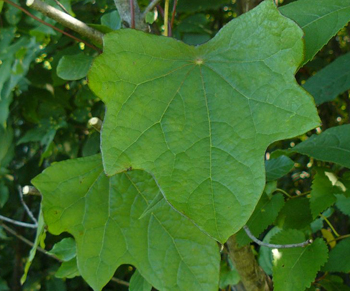Contents:
Common Names | Parts Usually Used | Plant(s) & Culture | Where Found | Medicinal Properties
Uses | Warning | Bibliography
Scientific Names

- Menispermum canadense L.
- Menispermaceae
- Moonseed family
Common Names
- American sarsaparilla
- Canadian Moonseed
- Moonseed
- Texas sarsaparilla
- Vine-maple
- Yellow parilla
- Yellow sarsaparilla
Parts Usually Used
Leaves and roots
Back to Top
Description of Plant(s) and Culture
A perennial vine; the round, woody, twining vine of the moonseed family, with small clusters of purple berries and crescent-shaped seeds. Climbing woody vine; 8-12 feet tall. Root is bright yellow within. The leaves are smooth, with 3-7 angles or lobes; stalk attached above the base. Flowers small, whitish; in loose clusters; June to August. The fruit is globular, bluish-black drupe upto 1/2 inch across; resemble grapes.
Back to Top
Where Found
Rich, moist thickets, moist woods, hedges near streams. Quebec, western New England south to Georgia; Arkansas; Oklahoma
Back to Top
Medicinal Properties
Bitter tonic, diuretic, laxative
Back to Top
Uses
Native Americans used root tea for indigestion, arthritis, bowel disorders; also as a blood cleanser and “female tonic”.
Externally, physicians used root (tincture) as a laxative, diuretic; for syphilis, general debility, and chronic skin infections. Sometimes used as a substitute for Sarsaparilla
Back to Top
Warning
Poisonous. Fatalities have been reported from children eating seeds and fruits. Some people reportedly confuse this plant with edible wild grapes.
Care should be taken to correctly identify this herb. The black/purple berries are poisonous. The toxicity of the rootstock is due to its bitter alkaloids.
Never use this herb without medical supervision.
Back to Top
Bibliography
![]() Eastern/Central Medicinal Plants
Eastern/Central Medicinal Plants, by Steven Foster and James A. Duke., Houghton Mifflin Company, 215 Park Avenue South, New York, NY 10000
![]() The Herb Book
The Herb Book, by John Lust, Bantam Books, 666 Fifth Avenue, New York, NY. copyright 1974.
 The Rodale Herb Book: How to Use, Grow, and Buy Nature’s Miracle Plants (An Organic gardening and farming book)
The Rodale Herb Book: How to Use, Grow, and Buy Nature’s Miracle Plants (An Organic gardening and farming book), edited by William H. Hylton, Rodale Press, Inc. Emmaus, PA, 18049., 1974
 Secrets of the Chinese Herbalists
Secrets of the Chinese Herbalists, by Richard Lucas, Parker Publishing Company, Inc., West Nyack, NY, 1987.
![]() Indian Herbalogy of North America
Indian Herbalogy of North America, by Alma R. Hutchens, Shambala Publications, Inc., Horticultural Hall, 300 Massachusetts Avenue, Boston, Massachusetts 02115, 1973
![]() Webster’s New World Dictionary
Webster’s New World Dictionary, Third College Edition, Victoria Neufeldt, Editor in Chief, New World Dictionaries: A Division of Simon & Schuster, Inc., 15 Columbus Circle, New York, NY 10023
